In the competitive world of compact cars, the Peugeot 208 and the Skoda Kamiq stand out as two strong contenders. While the former leans into the hatchback offering versatility and urban charm, the latter brandishes the characteristics of a compact SUV, promising ruggedness and additional cargo capacity. In this article, we will delve into the technical aspects and innovations that define these two models, helping buyers make an informed choice.
Peugeot 208 vs Skoda Kamiq – Which model is better for everyday use?
Compare performance, boot capacity, efficiency and price at a glance.
Find out which car is the better choice for you – Peugeot 208 or Skoda Kamiq?
Design and Dimensions
The Peugeot 208 boasts a graceful hatchback silhouette, measuring 4055 mm in length, 1745 mm in width, and 1430 mm in height. It offers a trunk capacity of 309 liters, ideal for daily urban commuting. In contrast, the Skoda Kamiq embodies SUV practicality, extending its length to 4241 mm, width to 1793 mm, and height to 1562 mm. This design allows for a much larger trunk space of 400 liters, catering well to families or adventure seekers.
Powertrains and Performance
Under the hood, the Peugeot 208 offers a range of engine options including petrol, petrol MHEV (mild hybrid electric vehicle), and fully electric variants. Power outputs range from 101 to 156 HP, with impressive torque figures peaking at 270 Nm. The 208 also boasts efficient fuel consumption starting at just 4.7 L/100 km and electric ranges of up to 410 km with its 51 kWh battery.
On the other hand, the Skoda Kamiq is powered by petrol engines with outputs from 95 to 150 HP, alongside torque reaching 250 Nm. While fuel consumption is slightly higher, averaging around 5.5 L/100 km, the Kamiq's engine options provide a sufficient blend of performance and efficiency for most drivers.
Transmission Options
Both models provide a choice of manual or automatic transmissions, but the Peugeot 208 showcases a dual-clutch automatic transmission that delivers smoother shifting. In comparison, the Kamiq features a traditional manual gearbox or dual-clutch automatic, depending on the selected engine power. This user-friendly approach in both models caters to varying preferences of driving enthusiasts.
Driving Experience and Comfort
Peugeot has integrated a unique i-Cockpit design within the 208, which enhances the driving experience with a compact steering wheel and a heads-up display, ensuring drivers remain engaged and informed. Acceleration from 0-100 km/h for the 208's most agile version clocks in at a phenomenal 8.3 seconds, promising spirited performance in urban settings.
The Skoda Kamiq, while not as quick in some variants, does maintain an engaging drive, achieving 0-100 km/h in as little as 8.3 seconds for its top engine variant. Its slightly elevated seating position and rugged build provide a feeling of greater control and visibility, especially in city traffic. Comfort features in both vehicles include ample legroom and innovative storage solutions tailored for modern lifestyles.
Safety Features and Innovations
Safety is paramount in both models, with the Peugeot 208 boasting a range of active and passive safety features, including lane departure warning and emergency braking. The Kamiq follows suit, equipped with advanced safety technologies like adaptive cruise control and blind-spot monitoring, ensuring peace of mind for families.
Final Verdict
Ultimately, choosing between the Peugeot 208 and the Skoda Kamiq boils down to personal preferences and lifestyle requirements. The 208 presents an agile, efficient hatchback with a strong electric option and stylish design, while the Kamiq offers an SUV charm with increased cargo capacity and robust safety features. Understanding these distinctions can guide buyers in selecting a vehicle that complements their journey ahead.
Here’s where it gets real: The technical differences in detail
Costs and Efficiency:
Looking at overall running costs, both models reveal some interesting differences in everyday economy.
Peugeot 208 has a barely noticeable advantage in terms of price – it starts at 20700 £, while the Skoda Kamiq costs 21700 £. That’s a price difference of around 1029 £.
Fuel consumption also shows a difference: Peugeot 208 manages with 4.50 L and is therefore a bit more efficient than the Skoda Kamiq with 5.30 L. The difference is about 0.80 L per 100 km.
Engine and Performance:
Power, torque and acceleration are the classic benchmarks for car enthusiasts – and here, some clear differences start to show.
When it comes to engine power, the Peugeot 208 has a hardly perceptible edge – offering 156 HP compared to 150 HP. That’s roughly 6 HP more horsepower.
In acceleration from 0 to 100 km/h, the Skoda Kamiq is barely noticeable quicker – completing the sprint in 8.10 s, while the Peugeot 208 takes 8.30 s. That’s about 0.20 s faster.
In terms of top speed, the Skoda Kamiq performs barely noticeable better – reaching 216 km/h, while the Peugeot 208 tops out at 200 km/h. The difference is around 16 km/h.
There’s also a difference in torque: Peugeot 208 pulls hardly perceptible stronger with 270 Nm compared to 250 Nm. That’s about 20 Nm difference.
Space and Everyday Use:
Beyond pure performance, interior space and usability matter most in daily life. This is where you see which car is more practical and versatile.
Both vehicles offer seating for 5 people.
In curb weight, Peugeot 208 is slight lighter – 1165 kg compared to 1231 kg. The difference is around 66 kg.
In terms of boot space, the Skoda Kamiq offers slightly more room – 400 L compared to 352 L. That’s a difference of about 48 L.
In maximum load capacity, the Skoda Kamiq performs somewhat better – up to 1395 L, which is about 232 L more than the Peugeot 208.
When it comes to payload, Skoda Kamiq noticeable takes the win – 539 kg compared to 430 kg. That’s a difference of about 109 kg.
Who wins the race?
The Skoda Kamiq proves to be is largely superior and therefore becomes our DriveDuel Champion!
Skoda Kamiq is the better all-rounder in this comparison.

Skoda Kamiq
Peugeot 208
The Peugeot 208 exudes a distinctive French charm, combining sleek lines with an assertive stance on the road. Inside, it offers a modern and sophisticated cabin, complete with intuitive technology and high-quality finishes to enhance the driving experience. Its agile handling and efficient performance make it a delightful choice for both city commuting and longer journeys.
details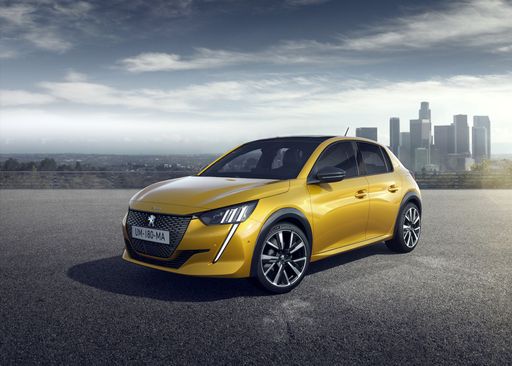 @ www.media.stellantis.com
@ www.media.stellantis.com
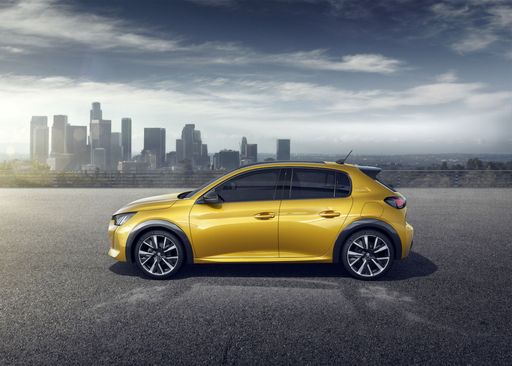 @ www.media.stellantis.com
@ www.media.stellantis.com
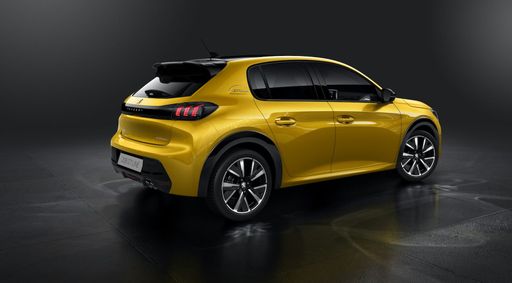 @ www.media.stellantis.com
@ www.media.stellantis.com
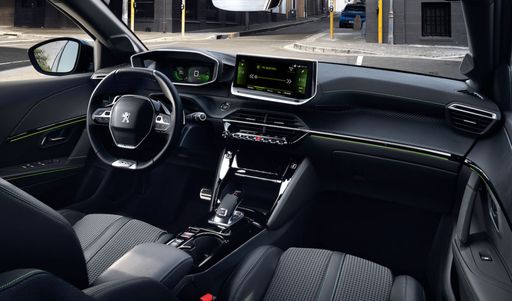 @ www.media.stellantis.com
@ www.media.stellantis.com
Skoda Kamiq
The Skoda Kamiq stands out in the compact SUV segment with its distinctive design and spacious interior. It offers a comfortable ride with advanced technology and safety features that make it suitable for both city driving and longer journeys. The Kamiq combines practicality with a touch of elegance, making it an appealing choice for those seeking a versatile vehicle.
details @ Skoda Presse Deutschland
@ Skoda Presse Deutschland
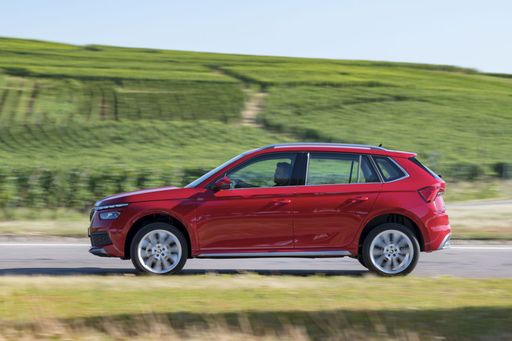 @ Skoda Presse Deutschland
@ Skoda Presse Deutschland
 @ Skoda Presse Deutschland
@ Skoda Presse Deutschland
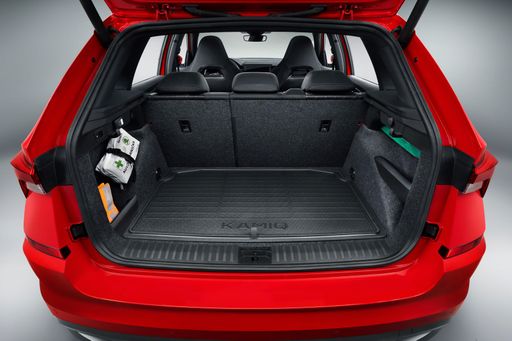 @ Skoda Presse Deutschland
@ Skoda Presse Deutschland
 @ Skoda Presse Deutschland
@ Skoda Presse Deutschland

|

|
|
|
|
Costs and Consumption |
|
|---|---|
|
Price
20700 - 35200 £
|
Price
21700 - 31900 £
|
|
Consumption L/100km
4.5 - 5.2 L
|
Consumption L/100km
5.3 - 5.7 L
|
|
Consumption kWh/100km
14.1 - 15.4 kWh
|
Consumption kWh/100km
-
|
|
Electric Range
362 - 432 km
|
Electric Range
-
|
|
Battery Capacity
46 - 51 kWh
|
Battery Capacity
-
|
|
co2
0 - 117 g/km
|
co2
121 - 128 g/km
|
|
Fuel tank capacity
44 L
|
Fuel tank capacity
50 L
|
Dimensions and Body |
|
|---|---|
|
Body Type
Hatchback
|
Body Type
SUV
|
|
Seats
5
|
Seats
5
|
|
Doors
5
|
Doors
5
|
|
Curb weight
1165 - 1530 kg
|
Curb weight
1231 - 1340 kg
|
|
Trunk capacity
309 - 352 L
|
Trunk capacity
400 L
|
|
Length
4055 mm
|
Length
4241 mm
|
|
Width
1745 mm
|
Width
1793 mm
|
|
Height
1430 mm
|
Height
1562 mm
|
|
Max trunk capacity
1118 - 1163 L
|
Max trunk capacity
1395 L
|
|
Payload
380 - 430 kg
|
Payload
439 - 539 kg
|
Engine and Performance |
|
|---|---|
|
Engine Type
Petrol, Electric, Petrol MHEV
|
Engine Type
Petrol
|
|
Transmission
Manuel, Automatic
|
Transmission
Manuel, Automatic
|
|
Transmission Detail
Manual Gearbox, Reduction Gearbox, Dual-Clutch Automatic
|
Transmission Detail
Manual Gearbox, Dual-Clutch Automatic
|
|
Drive Type
Front-Wheel Drive
|
Drive Type
Front-Wheel Drive
|
|
Power HP
101 - 156 HP
|
Power HP
95 - 150 HP
|
|
Acceleration 0-100km/h
8.3 - 10.9 s
|
Acceleration 0-100km/h
8.1 - 11 s
|
|
Max Speed
150 - 200 km/h
|
Max Speed
183 - 216 km/h
|
|
Torque
205 - 270 Nm
|
Torque
175 - 250 Nm
|
|
Number of Cylinders
3
|
Number of Cylinders
3 - 4
|
|
Power kW
74 - 115 kW
|
Power kW
70 - 110 kW
|
|
Engine capacity
1199 cm3
|
Engine capacity
999 - 1498 cm3
|
General |
|
|---|---|
|
Model Year
2023 - 2025
|
Model Year
2025
|
|
CO2 Efficiency Class
D, A, C
|
CO2 Efficiency Class
D
|
|
Brand
Peugeot
|
Brand
Skoda
|
What drive types are available for the Peugeot 208?
The Peugeot 208 is offered with Front-Wheel Drive.
The prices and data displayed are estimates based on German list prices and may vary by country. This information is not legally binding.
